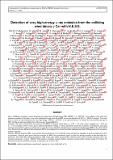Por favor, use este identificador para citar o enlazar a este item:
http://hdl.handle.net/10261/231226COMPARTIR / EXPORTAR:
 SHARE SHARE
 CORE
BASE CORE
BASE
|
|
| Visualizar otros formatos: MARC | Dublin Core | RDF | ORE | MODS | METS | DIDL | DATACITE | |

| Título: | Detection of very-high-energy γ -ray emission from the colliding wind binary η Car with H.E.S.S. |
Autor: | Abdalla, H.; Cerruti, Matteo; Żywucka, Natalia; H.E.S.S. Collaboration | Palabras clave: | Astroparticle physics Binaries: general Cosmic rays Radiation mechanisms: non-thermal Stars: individual: η CarStars: Wolf-Rayet |
Fecha de publicación: | 1-mar-2020 | Editor: | EDP Sciences | Citación: | Astronomy and Astrophysics 635: A167 (2020) | Resumen: | Aims. Colliding wind binary systems have long been suspected to be high-energy (HE; 100 MeV < E < 100 GeV) γ-ray emitters. η Car is the most prominent member of this object class and is confirmed to emit phase-locked HE γ rays from hundreds of MeV to ~100 GeV energies. This work aims to search for and characterise the very-high-energy (VHE; E >100 GeV) γ-ray emission from η Car around the last periastron passage in 2014 with the ground-based High Energy Stereoscopic System (H.E.S.S.). Methods. The region around η Car was observed with H.E.S.S. between orbital phase p = 0.78-1.10, with a closer sampling at p ≈ 0.95 and p ≈ 1.10 (assuming a period of 2023 days). Optimised hardware settings as well as adjustments to the data reduction, reconstruction, and signal selection were needed to suppress and take into account the strong, extended, and inhomogeneous night sky background (NSB) in the η Car field of view. Tailored run-wise Monte-Carlo simulations (RWS) were required to accurately treat the additional noise from NSB photons in the instrument response functions. Results. H.E.S.S. detected VHE γ-ray emission from the direction of η Car shortly before and after the minimum in the X-ray light-curve close to periastron. Using the point spread function provided by RWS, the reconstructed signal is point-like and the spectrum is best described by a power law. The overall flux and spectral index in VHE γ rays agree within statistical and systematic errors before and after periastron. The γ-ray spectrum extends up to at least ~400 GeV. This implies a maximum magnetic field in a leptonic scenario in the emission region of 0.5 Gauss. No indication for phase-locked flux variations is detected in the H.E.S.S. data. | Versión del editor: | http://doi.org/10.1051/0004-6361/201936761 | URI: | http://hdl.handle.net/10261/231226 | DOI: | 10.1051/0004-6361/201936761 | Identificadores: | doi: 10.1051/0004-6361/201936761 issn: 1432-0746 |
| Aparece en las colecciones: | (ICE) Artículos |
Ficheros en este ítem:
| Fichero | Descripción | Tamaño | Formato | |
|---|---|---|---|---|
| Detection_of_very-high-energy_γ-ray_emission_from_the_colliding.pdf | 988,57 kB | Adobe PDF |  Visualizar/Abrir |
CORE Recommender
SCOPUSTM
Citations
13
checked on 21-abr-2024
WEB OF SCIENCETM
Citations
10
checked on 23-feb-2024
Page view(s)
76
checked on 01-may-2024
Download(s)
61
checked on 01-may-2024
Google ScholarTM
Check
Altmetric
Altmetric
NOTA: Los ítems de Digital.CSIC están protegidos por copyright, con todos los derechos reservados, a menos que se indique lo contrario.
